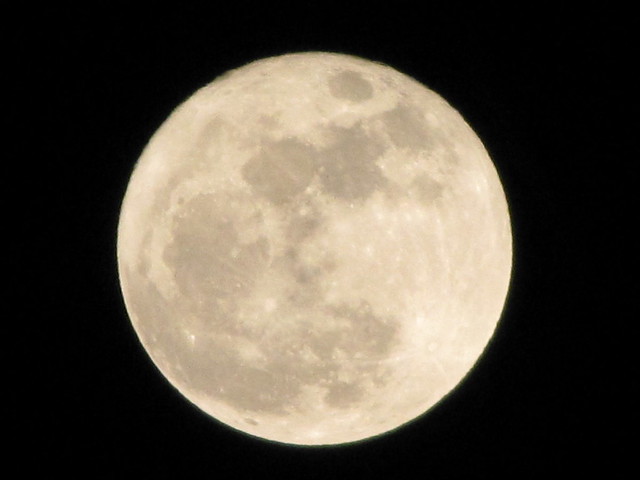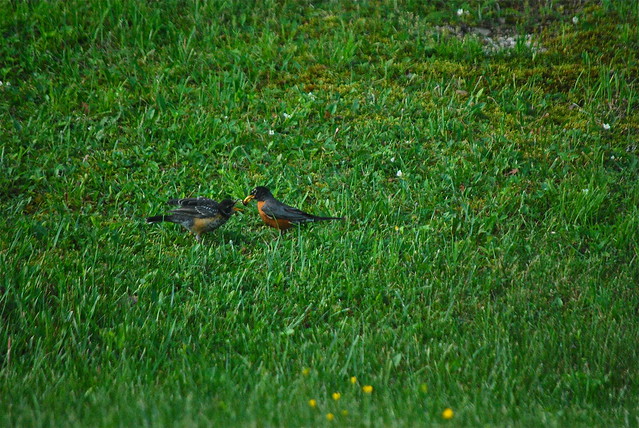Open fires are prohibited throughout the park from midnight to 4 p.m. through April 30 per the 4 p.m. Burning Law. This includes wood and charcoal. Gas is permissible. Campground fires are allowed during the restricted time if a camp host is on duty and signage to that effect is posted in the campground. Failure to observe the 4 p.m. Burning Law can result in a fine. Contact the Park Office for additional information.
Read Our Blogs
Full Moon of the Month: Worm Moon
The moon draws our attention in many ways, effecting our world and culture across the globe. It has plenty of artistic lore, for good reason, but the moon also holds practical observation, being a keeper of time and the seasons for thousands of years.
 The moon is on average 239,000 miles from Earth
The moon is on average 239,000 miles from Earth
Photo courtesy of beaumontpete, Creative Commons license.
Since the moon’s lunar cycle of 29.5 days is so close to our monthly calendar, we typically have one full moon per month. People of long ago noticed, naming the moons seasonally as a marker of time and change.
I remember as a child hearing the full moons being called by different names and wondering, "What is that all about?" I thought the moon was just the moon. It turns out people have named the moons for centuries, connecting those names to the seasons and happenings of the land and ecosystems.
Every full moon has its own name and on March 23 we'll have our first full moon of spring
Historically around Virginia one of the names to befall the moon this March 23rd is the Full Worm Moon. Different cultures have different names for the moon just as they do for the stars and constellations.
Does the moon have anything to do with worms? Not really. While this sounds like an odd name, the Worm Moon originates from long ago as winter wanes, and warmer weather is on the horizon. The ground begins to sluggishly warm and thaw and worms become more active. Their castings begin to show up, which is a welcome sight to returning robins as well. Robins return in addition to many other winged friends, migrating back from far and wide. These occurrences are a welcome sight to us all.

A robin handing off food, perhaps proving his fitness, perhaps helping his mate
The Full Worm Moon is a reminder of a species we think little about, the worms, which benefit soil health and food webs everywhere. It’s a sign we made it through the worst of winter and a reminder spring is coming. Many people of yesteryear and some still today take this as a sign it is time to begin preparing the fields for gardens and crops. (Preparing, since many of us remain within frost potential into April).
The cold of winter will fade to buds and blooms and hillsides of green and color once again. By next month’s Full Moon in April, the Full Pink Moon, the phlox and many flowers will speckle our trails and woods and fields.
This moon also has a connection to Easter. If you’ve ever wondered why Easter is sometimes celebrated in March and sometimes in April, here’s the deal. March 20 is the first day of spring, the vernal equinox. Easter is always the first Sunday after the first full moon of spring. So since the Worm Moon lands on March 23rd this year, just a few days after spring starts, we’re having a relatively early Easter.
Check back for more fun lunar tidbits and stories of each month’s moon throughout the year. Not many objects grab our attention in the night sky like the moon. Our history and culture and forever tethered to Earth’s only natural satellite.
On this full moon, think of the worms, eating and digging through the dirt. This full moon we eagerly greet the coming spring.
Visit a Virginia State Park this spring, where you have 36 parks to choose from,
click here to find one near you
If you have read the article and have a question, please email nancy.heltman@dcr.virginia.gov.
Search for blogs
By Park
Categories
Cabins
Camping
Fishing
History and Culture
Other
Programs and Events
Trails
Volunteers
Water Fun
Archive
2024
2023
2022
2021
2020
2019
2018
2017
2016
2015
2014
2012














